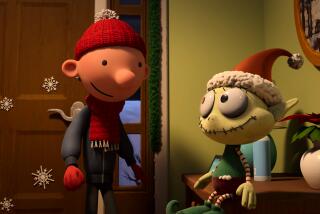MOVIE REVIEW : Old-Fashioned Family Fun in the ‘Jungle’
- Share via
Though aimed at younger audiences, “Rudyard Kipling’s The Jungle Book” makes its case for the nobility of the “wild child” in a manner more entertaining and far less condescending than the recent Jodie Foster vehicle, “Nell.”
This is Hollywood’s third pass on Kipling’s adventures of Mowgli, the young Indian raised by wild animals. In Zoltan Korda’s 1942 adaptation, Mowgli simply wandered from his family before encountering his bestial tutors. This being 1994, however, gunshots and fireballs and vehicular peril must accompany his disappearance from civilization (some of this film’s mayhem, in fact, may be too extreme for younger moviegoers).
Virtually the whole of Disney’s 1967 animated “Jungle Book”--paid homage to here in a throwaway line about “bare necessities”--took place in the middle of a trick shot here, where the tyke Mowgli steps behind some brush and emerges as the fully grown, fully buff Jason Scott Lee.
Returning to civilization, Mowgli is smitten with Kitty (Lena Headey), a young woman he knew as a child. Kitty and the jolly Dr. Plumford (John Cleese) take to this placid savage, while Kitty’s boyfriend, the yuppie-prototype Boone (Cary Elwes), clearly does not; her father, Major Brydon (Sam Neill), is likewise less than sanguine about his daughter making time with such a raw specimen.
Ever the colonialist, Boone decides to exploit the locals, bullying Mowgli into showing him an enormous hidden treasure trove. Mowgli must dispatch Boone and his cackling cronies and rescue Kitty, Brydon and Plumford.
Director/co-writer Stephen Sommers earlier scripted the banal “Gunmen” and wrote and directed “The Adventures of Huck Finn.” In a strange way, he’s melding those two pictures into one, and in a stranger way, he succeeds, for his “Jungle Book” provides both rowdy thrills and old-fashioned family entertainment.
Sommers achieves some neat effects here, particularly in scenes in which scores of animals react to Mowgli’s misadventures in an amusingly anthropomorphic fashion (29 trainers are credited). His location crew--the film was shot in England, India and the United States--found expansive panoramas and gorgeous scenery. Yet there’s the occasional cheesy process shot or unconvincing matte painting, suggesting Sommers overreached a bit on his limited budget.
Still, not many live-action Disney films in the past few years have been accused of being too ambitious, and Sommers offers enough wit to engage the adults while kids can enjoy the evergreen premise of Kipling’s yarn.
Lee plays an innocent credibly and expressively in an almost mute performance. Elwes’ character revels in evil with absolutely brittle wit. One wishes that more use could have been found for Neill and Cleese, who seem more than willing to play along.
But even at its most workmanlike, “Jungle Book” entertains in a way both contemporary and traditional. And how long has it been since you’ve seen a movie where someone drowns in quicksand?
* MPAA-rating: PG, for “action/violence and some mild language.” Times guidelines: It includes many scenes of mayhem, including the shooting of people and animals, which may upset younger children.
(BEGIN TEXT OF INFOBOX / INFOGRAPHIC)
‘Rudyard Kipling’s The Jungle Book’
Jason Scott Lee: Mowgli Cary Elwes: Boone Lena Headey: Kitty Sam Neill: Brydon John Cleese: Dr. Plumford A Walt Disney Pictures presentation of a Sharad Patel production, released by Buena Vista Pictures. Director Stephen Sommers. Producer Edward S. Feldman, Raju Patel. Executive producer Sharad Patel, Mark Damon, Lawrence Mortorff. Screenplay by Stephen Sommers and Ronald Yanover & Mark D. Geldman. Cinematographer Juan Ruiz-Anchia. Editor Bob Ducsay. Costumes John Mollo. Music Basil Poledouris. Production design Allan Cameron. Set decorator Crispian Sallis. Running time: 1 hour, 48 minutes.
* In general release throughout Southern California.
More to Read
Only good movies
Get the Indie Focus newsletter, Mark Olsen's weekly guide to the world of cinema.
You may occasionally receive promotional content from the Los Angeles Times.










